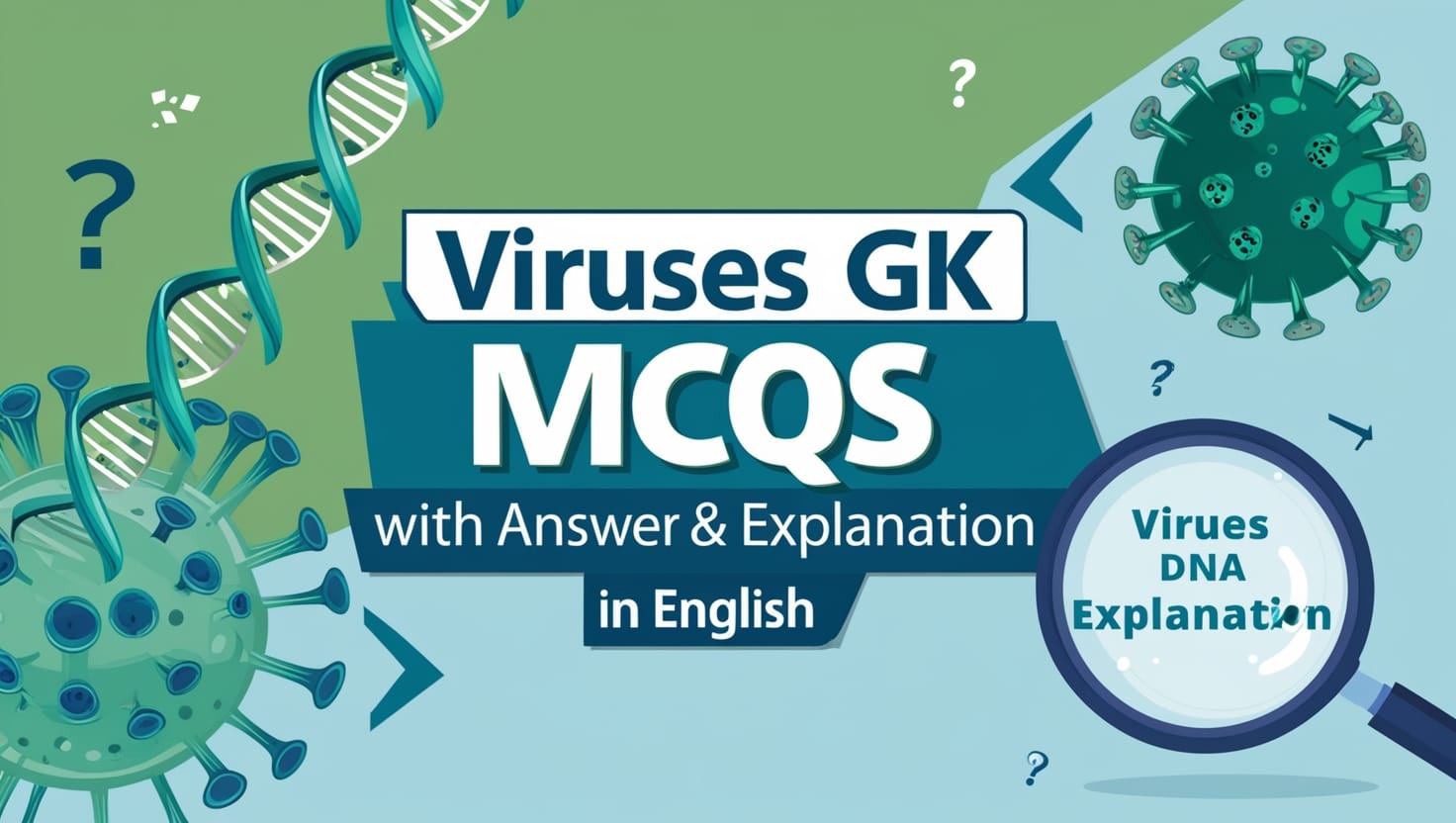
1. Rinderpest” disease, which was recently eliminated was caused by which among the following?
- Fungi
- Nematode
- Bacteria
- Virus
Show Answer
Answer: Virus
Rinderpest was a highly contagious viral disease that primarily affected cattle and related ungulates. It caused significant economic losses and posed a threat to food security. However, through concerted global efforts, particularly vaccination campaigns led by organizations like the Food and Agriculture Organization (FAO) and the World Organisation for Animal Health (OIE), rinderpest was successfully eradicated. In 2011, the World Organization for Animal Health declared global freedom from rinderpest, making it the second disease, after smallpox, to be eradicated.
2. Which among the following is the correct definition of Bacteriophage?
- Bacteria that destroys another Bacteria
- Bacteria that destroys Fungi
- Bacteria that destroys Virus
- Virus that destroys Bacteria
Show Answer
Answer: Virus that destroys Bacteria
Bacteriophages, or phages, are viruses that infect and replicate within bacteria. They are instrumental in genetic research, particularly in molecular biology and biotechnology. Bacteriophages serve as valuable tools for manipulating bacterial genes, studying gene expression, and facilitating genetic engineering. Phages are employed in techniques like phage display, where they can express foreign peptides on their surfaces, aiding the study of protein-protein interactions and the development of therapeutic proteins.
3. Which disinfectant is effective against viruses?
- Formaldehyde
- Hypochlorite
- Hydrogen peroxide
- All of these
Show Answer
Answer: All of these
Hydrogen peroxide, hypochlorite (commonly found in bleach), and formaldehyde are potent disinfectants with broad-spectrum antimicrobial activity, including efficacy against viruses. These chemicals work by disrupting the viral envelope or protein coat, rendering the virus non-infectious. They are commonly used in healthcare settings, laboratories, and various industries to sanitize surfaces, equipment, and materials.
4. Which of the following is required by viruses for growth?
- Animals
- Living cells
- Bacteria
- Plants
Show Answer
Answer: Living cells
Viruses are obligate intracellular parasites, meaning they cannot carry out essential life processes outside a host cell. To reproduce, viruses need to infect a living host cell, where they hijack the host’s cellular machinery to replicate their genetic material and produce new viral particles. This dependence on host cells is a defining characteristic of viruses and distinguishes them from living organisms that can carry out independent cellular activities.
5. When is reverse transcriptase a useful enzyme?
- Nutrients are scarce
- Spikes are forming in the new virus
- An RNA virus converts its RNA to DNA
- There are no host cells present
Show Answer
Answer: An RNA virus converts its RNA to DNA
Reverse transcriptase is an enzyme found in retroviruses, a group of RNA viruses. When an RNA virus infects a host cell, reverse transcriptase facilitates the conversion of the viral RNA genome into DNA. This DNA, known as complementary DNA (cDNA), can then integrate into the host cell’s genome. This process is a crucial step in the life cycle of retroviruses, such as HIV. Integration allows the viral genetic material to become a permanent part of the host cell’s DNA, leading to persistent infections. Understanding reverse transcriptase has been pivotal in the development of antiretroviral drugs and research on gene therapy.
6. Viruses are usually divided into several large groups based mainly on?
- Capsid symmetry
- Diameter of the viroin or nucleocapsid
- Nature of the host
- Nucleic acid characteristics
Show Answer
Answer: Nature of the host
The classification of viruses is primarily based on the nature of the host they infect and the type of genetic material they possess. Viruses can infect animals, plants, bacteria (bacteriophages), or archaea. Additionally, they are categorized based on whether their genetic material is composed of DNA or RNA, the structure of their capsid (protein coat), and the presence or absence of an envelope. This systematic classification helps scientists understand the diversity of viruses and their interactions with different host organisms.
7. Which of the following viruses is not linked to human cancer?
- Varicella-Zoster virus
- Herpes simplex virus type 2
- Hepatitis C virus
- Hepatitis B virus
Show Answer
Answer: Varicella-Zoster virus
Certain viruses have been identified as oncogenic, meaning they have the potential to cause cancer. Hepatitis C virus (HCV), Hepatitis B virus (HBV), and Herpes simplex virus type 2 (HSV-2) are known to be associated with human cancer. Chronic infections with HCV and HBV are linked to liver cancer, while HSV-2 has been implicated in cervical and other genital cancers. In contrast, the Varicella-Zoster virus, which causes chickenpox and shingles, is not generally associated with human cancer.
8. Viral nucleocapsid is a combination of which of the following?
- Envelope and capsid
- Capsomere and genome
- Genome and capsid
- Capsid and spikes
Show Answer
Answer: Genome and capsid
The viral nucleocapsid is a fundamental structure in viruses, comprising the viral genome (either DNA or RNA) and the protein capsid that encapsulates it. The capsid provides protection to the viral genetic material and plays a crucial role in the virus’s ability to infect host cells. The nucleocapsid may have various shapes, such as icosahedral, helical, or complex, depending on the virus type. Understanding the composition and structure of the nucleocapsid is essential for unraveling the mechanics of viral infection and developing antiviral strategies.
9. Complete the sentence: “The viruses in an attenuated vaccine __?”
- are usually larger than bacteria
- is altered with chemicals
- have no genome
- continue to replicate
Show Answer
Answer: continue to replicate
Attenuated vaccines are created by weakening the pathogenicity of a live virus or bacterium, often through serial passages in cell culture. Despite their weakened state, viruses in attenuated vaccines retain the ability to replicate within the host. This replication triggers a robust immune response, leading to the production of antibodies and the development of immunological memory. While attenuated vaccines are effective in inducing strong and long-lasting immunity, they do not typically cause disease in the vaccinated individual. This is in contrast to the wild form of the organism, which can cause illness. Attenuated vaccines have been successful in preventing diseases such as measles, mumps, rubella, and yellow fever.
10. Which of the following can be done in the cultivation of plant viruses?
- whole plants
- cultures of separated cells
- tissue culture
- All of these
Show Answer
Answer: All of these
Plant viruses can be cultivated using various methods, including tissue culture, cultures of separated cells, and whole plants. Tissue culture involves growing plant cells in a nutrient-rich medium under controlled conditions. Cultures of separated cells allow researchers to study individual cells infected with the virus. Additionally, whole plants can be infected, and the virus can be propagated within the plant. These cultivation methods are essential for studying the biology of plant viruses, understanding their interactions with host cells, and developing strategies for disease control.







